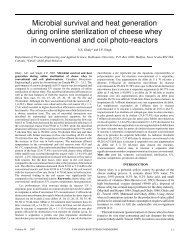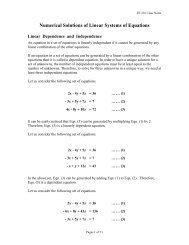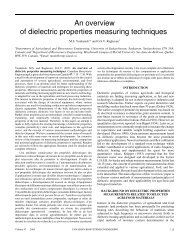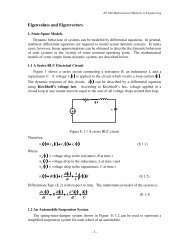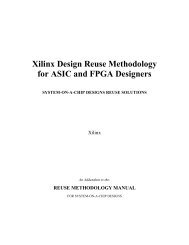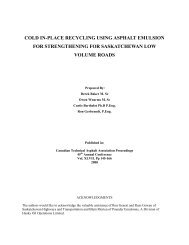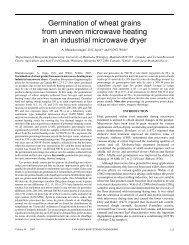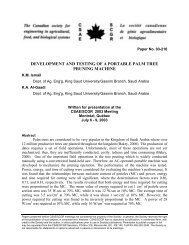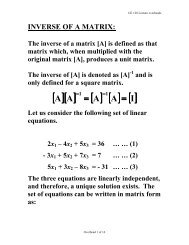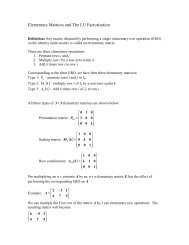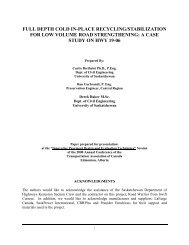comparison of alternative asphalt concrete rut characterization
comparison of alternative asphalt concrete rut characterization
comparison of alternative asphalt concrete rut characterization
You also want an ePaper? Increase the reach of your titles
YUMPU automatically turns print PDFs into web optimized ePapers that Google loves.
BERTHELOT, CROCKFORD & LYTTON 14Table 13 Complex SHRP Shear Modulus Measurements and Duncan’s Pairwise Comparison at 10Hz Cyclic Frequency <strong>of</strong> Radisson Specific Pavement Studies-9A Asphalt Concrete Mixes Groupedby Test TemperatureSPS-9A TestSectionMean ComplexSHRP ShearModulus(MPa)Mean ComplexSHRP ShearModulusCoefficient <strong>of</strong>Variation(Percent)Duncan's Grouping *900901 827.791 8.39 B900902 1491.639 55.21 A900903 855.529 11.15 B900959 1029.969 24.37 B900960 798.400 11.26 B900961 655.615 31.59 B900962 681.342 8.38 BMean 905.755 21.48* Asphalt <strong>concrete</strong> mixes with same letter are not significantly different.Table 14 Complex SHRP Shear Modulus Measurements and Duncan’s Pairwise Comparison at 10Hz Cyclic Frequency across Test Temperatures Grouped by Radisson Specific Pavement Studies-9A Asphalt Concrete MixTestTemperatureMean ComplexSHRP ShearModulus(MPa)Mean ComplexSHRP ShearModulusCoefficient <strong>of</strong>Variation(Percent)Duncan's Grouping*4°C 1981.779 15.56 A20°C 526.286 14.97 B40°C 209.170 33.90 CMean 905.745 21.48* Test temperatures with same letter are not significantly different.Tables 15 and 16 summarize the mean complex SHRP shear phase angle measurements at 10 Hz cyclicfrequency across the Radisson SPS-9A <strong>asphalt</strong> <strong>concrete</strong> mixes and test temperatures, respectively. Astatistical analysis was performed at a 95 percent confidence level to evaluate the statistical significance<strong>of</strong> the mean SHRP shear phase angle measurements at 10 Hz cyclic frequency across the Radisson SPS-9A <strong>asphalt</strong> <strong>concrete</strong> mixes and test temperatures employed in the analysis. A two-way analysis <strong>of</strong>variance concluded that Radisson SPS-9A <strong>asphalt</strong> <strong>concrete</strong> mix type and test temperature had asignificant effect on the mean SHRP shear phase angle measurements. However, the interaction effectsbetween Radisson SPS-9A <strong>asphalt</strong> <strong>concrete</strong> mix type and test temperature was found not to have asignificant effect on the mean SHRP shear phase angle measurements. Duncan's pairwise <strong>comparison</strong> <strong>of</strong>the mean SHRP shear phase angle measurements at 10 Hz cyclic frequency for each Radisson SPS-9A<strong>asphalt</strong> <strong>concrete</strong> mix grouped by test temperature determined that: mixes 900901, 900903, 900959,900960, and 900961 were not significantly different; and mixes 900902 and 900962 were notsignificantly different. Duncan's pairwise <strong>comparison</strong> <strong>of</strong> the mean SHRP shear phase anglemeasurements at 10 Hz cyclic frequency across test temperatures grouped by Radisson SPS-9A <strong>asphalt</strong>



